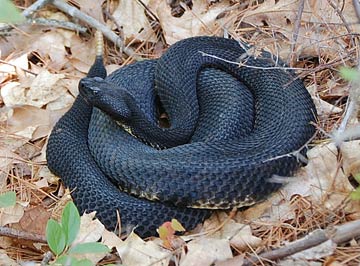Timber Rattlesnake
Crotalus horridus
 NH Conservation Status: State Endangered; Wildlife Action Plan Species in Greatest Need of Conservation
NH Conservation Status: State Endangered; Wildlife Action Plan Species in Greatest Need of Conservation
State Rank Status: Critically imperiled (S1)
Distribution: Historically ranged from Massachusetts border up to the White Mountains. Currently there is only one known population in NH.
Description: A large, thick black snake measuring 36-60 inches. Brown cross-bands arranged across the surface may be difficult to see. Has a large triangular head and keeled scales giving them a rough appearance. At the end of the tail there is a large, blunt rattle.
Commonly Confused Species: Milk snake, northern water snake, black racer snake; garter snake
Habitat: Rocky, south-facing hillsides in wooded areas that are exposed to an abundance of sunlight. Rock ledges and outcroppings on hilltops are used for basking. Deep rock crevices are used as den sites for hibernation. During summer their habitat expands to brushy, forested areas where they often bask in sunspots. Males may travel several miles from den sites during summer and return in the fall.
Life History: Timber rattlesnakes give birth to live young in the fall before returning to the den to hibernate from November until May. They den communally and will use the same den site for generations.
Conservation Threats: Habitat loss and destruction, disease, gravel mining, mortality on roadways, illegal collection or killing of snakes by humans.



